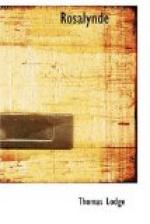[Footnote 1: Steele, speaking of the pastoral (The Guardian, No. 30), says, “The difference of the climate is also to be considered, for what is proper in Arcadia, or even in Italy, might be quite absurd in a colder country.”]
[Footnote 2: Though not published till 1598, Bartholomew Young’s translation of the “Diana” was made in 1583.]
[Footnote 3: In the epistle To the Gentlemen Readers, prefixed to “A Margarite of America,” he tells us that he read the original of that story “in the Library of the Jesuits in Sanctum ... in the Spanish tongue.”]
[Footnote 4: Jusserand, “The English Novel in the Time of Shakespeare,” p. 236.]
Style: Euphuistic. Nor was Lodge more original in his manner than in his matter. His style is that of the euphuists. John Lyly’s “Euphues, or the Anatomy of Wit” (1579), and its sequel “Euphues and His England” (1580), had set a fashion that was destined for the next two decades to enjoy a tremendous vogue. Lyly’s was the first conspicuous example in English of the attempt to achieve an ornate and rather fantastic style. The result became known as euphuism, and those who employed it as euphuists. In its essential features it consists of three distinct mannerisms: a balance of phrases, an elaborate system of alliteration, and a profusion of similes taken from fabulous natural history. Regarding the euphuistic use of balance, Dr. Landmann says of Lyly’s prose:[1] “We have here the most elaborate antithesis not only of well balanced clauses, but also of words, often even of sentences.... Even when he uses a single sentence he opposes the words within the clause to each other.”
[Footnote 1: In “Shakspere and Euphuism,” Transactions of the New Shakspere Society, 1880-1882.]




